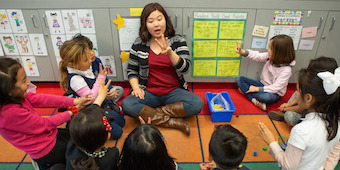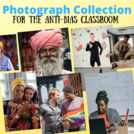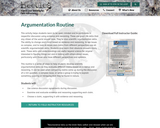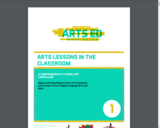
Contains cover sheet and teacher example/artifact.
- Subject:
- Composition and Rhetoric
- Elementary Education
- Language, Grammar and Vocabulary
- Material Type:
- Lesson Plan
- Author:
- Johanna Richards
- Date Added:
- 05/22/2019


Contains cover sheet and teacher example/artifact.

Acceso is a complete, interactive curriculum for intermediate-level learners of Spanish. The materials on the site are provided freely to the public and are intended as a replacement for commercial textbooks, which are generally ill-suited to the learning outcomes now considered crucial to successful language study. These materials are supplemented by an online workbook built on the MySpanishLab platform of Pearson Education, Inc., as well as detailed lesson plans, rubrics for the evaluation of student work, and reliable instruments for measuring student progress and learning outcomes. Winner of 2012 Computer Assisted Language Consortium (CALICO) Focus Award
Reviews
CALICO Journal 29.2 (Jan 2012): 398-405.
Hispania 95.2 (June 2012): 365-366

Classification of Analytical Methods

A comprehensive collection of documents originally created to assist human services professonals and regional training academies with creating accessible content, including guides, walkthrough videos, checklists and practice documents.Navigate between sections using the dropdown menu at the top of the page!

This animation seeks to lead students to a deeper understanding of the challenges that come with online learning for those with disabilities, and a newfound or renewed sense of empathy towards others.
Music by VYEN.

In this activity students analyze the reasons why the Montgomery Bus Boycott lasted so long and was successful. Students watch a short clip from the PBS documentary Eyes on the Prizeabout the Montgomery Bus Boycott. Then students analyze primary sources to determine who participated in the boycott, who organized it, and what challenges boycott supporters faced. The teacher will need access to the filmEyes on the Prize, which is widely available in school and public libraries.

Checklist that can be used as a guide in analyzing the assignment examples

This collection was inspired by Ellen Wolpert's article about anti-bias work with younger students. Her article suggests that teachers should keep a collection of non-stereotypical photos of people doing regular things that can be referenced to stimulate class discussion or address biased language with young children.
The photos in this growing collection are organized into (Google Drive) folders inspired by categories mentioned by Ms. Wolpert: Race, Age, Physical Abilities, Gender Roles, Families/Sexual Orientation, Jobs, and Ethnicity. Each folder contains different photographs curated from various Creative Commons websites, including Unsplash, Pixabay, and Pexels. Currently there are 80 photographs in the collection. They have been assembled here for your convenience and represent many hours of searching, downloading, and editing.
Reference: Wolpert, E. (2006). Photo picture cards: A key tool for the anti-bias classroom. In Lee, E., Menkart, D., & Okazawa-Rey, M. (Eds.) Beyond heroes and holidays: A practical guide to K-12 anti-racist, multicultural education and staff development (3rd ed., pp. 211-214).

A research article with information on the differences between rubrics, checklists, and rating scales. It includes helpful tips for quality rubric design.

This activity helps students learn to be open-minded and to participate in respectful discussion using evidence and reasoning. These are great life skills that any citizen of the world should have. They’re also scientific argumentation skills. The ability to change one’s mind based on evidence and reasoning, to see issues as complex, and to look at issues and claims from different perspectives are all scientific argumentation skills. Students also learn that absolute answers rarely exist. These skills and understandings are useful beyond science for anyone interested in figuring things out and in talking with others about issues, particularly with those who have different perspectives and opinions.

These active process-oriented lessons focus on concepts of line direction and type, organic shape, 3-D form, real and implied texture, secondary color, and principles of composition. Literacy-infused lessons explore text direction/spacing, observation, description, and story elements through drawing, painting, collage, clay modeling and printmaking.
The K-6 lesson handbooks were originally produced for the Lake Washington School District with grants from 4culture and ArtsWA. Encourage your colleagues, other schools, and organizations to use these materials for non-commercial, educational purposes at no cost by downloading their own copy at: http://artsedwashington.org/portfolio-items/alic-2

A broad range of art is created using concepts of contour and line type, abstraction, color palette, 3-D form, and positive and negative space. Students make both realistic and abstract drawings, relief prints, paintings, and paper sculptures. Literacy-infused lessons include making sketch/journal entries, inventing clay characters and illustrating stories and poems in collage.
The K-6 lesson handbooks were originally produced for the Lake Washington School District with grants from 4culture and ArtsWA. Encourage your colleagues, other schools, and organizations to use these materials for non-commercial, educational purposes at no cost by downloading their own copy at: http://artsedwashington.org/portfolio-items/alic-2

Fundamental concepts and skills are applied in new ways. Line is used to invent characters in monotype prints and show figures in action within drawings and wire sculptures. Elements of scale, horizon, overlapping, shape and texture in painting and printmaking reference specific time and place for settings. Students also visualize and write in response to art.
The K-6 lesson handbooks were originally produced for the Lake Washington School District with grants from 4culture and ArtsWA. Encourage your colleagues, other schools, and organizations to use these materials for non-commercial, educational purposes at no cost by downloading their own copy at: http://artsedwashington.org/portfolio-items/alic-2

Building traditional skills in drawing and painting is emphasized through study of proportion, value, color mixing, and space. Principles of balance and unity in 2-D and 3-D are explored through constructing tactile collages and paper sculptures. In literacy infused lessons, students connect word choice, detail, narrative and figurative language with images.
The K-6 lesson handbooks were originally produced for the Lake Washington School District with grants from 4culture and ArtsWA. Encourage your colleagues, other schools, and organizations to use these materials for non-commercial, educational purposes at no cost by downloading their own copy at: http://artsedwashington.org/portfolio-items/alic-2

Skills are refined through making pen and ink drawings, watercolor paintings, and sculptures focusing on proportion, value, and scale. Translating words into pictures and pictures into words is investigated through depicting setting, combining shapes for meaning, using color for mood and responding to art. Students also create prints and then explain the printmaking procedure in writing.
\The K-6 lesson handbooks were originally produced for the Lake Washington School District with grants from 4culture and ArtsWA. Encourage your colleagues, other schools, and organizations to use these materials for non-commercial, educational purposes at no cost by downloading their own copy at: http://artsedwashington.org/portfolio-items/alic-2

This creative start introduces concepts of line variety, geometric shape, actual texture, primary color, and pattern through exploratory drawing, painting, collage, and stamping. In literacy infused lessons, students make decorative letters, identify word sequence, analyze visual clues, and develop pictures by linking words and images.
The K-6 lesson handbooks were originally produced for the Lake Washington School District with grants from 4culture and ArtsWA. Encourage your colleagues, other schools, and organizations to use these materials for non-commercial, educational purposes at no cost by downloading their own copy at: http://artsedwashington.org/portfolio-items/alic-2

Several assignments are used for this course, including writing lesson plans, writing a unit plan, creating supplemental items for the unit plan, and designing a classroom management plan. In my course, I assign two units with three lesson plans included in each unit. This is designed for Early Childhood, but it can be edited for secondary.

We know you have come to this tutorial because you are a serious writer who wants to write well — and correctly! You have probably heard the word plagiarism and would like to understand it better. You have come to the right place. In this tutorial, you’ll learn:
What plagiarism is
How to recognize seven different kinds of plagiarism
The correct way to use ‘open access’ materials
The consequences of plagiarism
How to avoid plagiarism by doing the following:
Citing sources correctly
Recognizing ‘common knowledge’
Writing good paraphrases
Writing good summaries
Taking careful notes

Plagiarism is presenting someone else's work as your own. It can include copying and pasting text from a website into a project that you're working on, or taking an idea from a book without including a citation to give credit to the book's author. Plagiarism is very common, and the internet has made it even more common. However, if you are careful to cite your sources, it's not too hard to avoid plagiarism.

This training video is part of a series dedicated to helping child welfare workers learn practical skills to cope with the emotional tolls of their very important work. In this video, a meditation specialist goes over basic meditation practices that can be completed in or around the workplace with minimal interruption time.